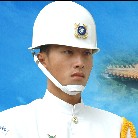| There
are seven major buildings in National Revolutionary Martyrs'
Shrine. We introduce from buildings in the front to the inside.
Also, we'll briefly introduce Zou-Ma Gallery (gallery over
the main hall) outside the Main Hall.
Archway Entrance (Chinese
Gateway)
The Archway Entrance is a three-gate concrete
architecture, covered with indigo glazed ceramic roof tiles.
It is the gate to enter National Revolutionary Martyrs' Shrine.
Three Chinese characters “忠烈祠” (chung lieh tzi-meaning Martyrs'
Shrine) are inscribed on the upper stone board of the middle
archway, two Chinese characters “成仁” (cheng ren-meaning to
die for righteousness) and “取義” (chiu yi-meaning to die for
justice) on both sides of archway. Martyrs' Shrine is to honor
the martyrs' spirit of righteousness and justice, so the government
build this grand archway entrance to declare this message
to the people.
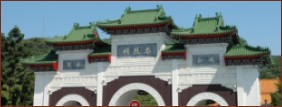 |
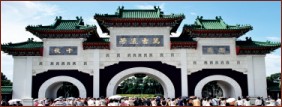 |
| The
front side of Archway Entrance of Martyrs' Shrine |
The
back side of Archway Entrance of Martyrs' Shrine |
Administration
Office and Archives
Administration Office is on the left hand side
of the square, while Archives is on the right. The unique roof
style of these two offices raises the center of the roof up
a layer. Both roofs are covered with indigo glazed ceramic roof
tiles.
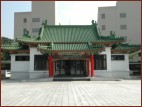 |
 |
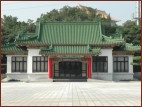 |
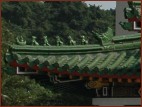 |
| Administration
Office |
The
memorial stone inscribed with the chronicle of Martyrs'
Shrine |
Archives |
The
Celestial and five mythical animals on the roof ridge |
Bell
Tower and Drum Tower
Bell Tower and Drum Tower are octagonal pagodas.
On the left hand side of the square is the Bell Tower, covered
with indigo glazed ceramic roof tiles. Inside the pagoda is
the bronze statue of martyr Lu Haou-Dong. On the second floor
placed a grand bell. On the right hand side of the square is
the Drum Tower. Inside the pagoda is the bronze statue of martyr
Shi Jian-Ru and a big drum is placed on the second floor. The
second floors of Drum Tower and Bell Tower are not open to the
public. Only during memorial service can authorities concerned
be allowed to go in.
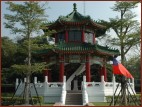 |
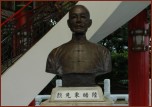 |
 |
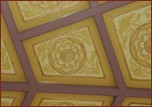 |
| Bell
Tower built in octagonal pagoda |
Bronze
statue of martyr Lu Haou-Dong |
Colorful
patterns between beams and pillars |
Patterns
on the ceiling of the pavilion |
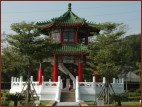 |
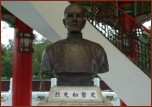 |
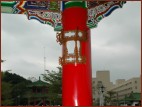 |
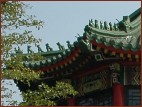 |
| Drum
Tower built in octagonal pagoda |
Bronze
statue of martyr Shi Jian-Ru |
Palace
lamp on the pillar |
The
Celestial and five mythical animals on the roof ridge |
Main
Gate
The Main Gate is a concrete structure, covered
with yellow glazed ceramic roof tile. Among the beams and pillars
are painted with dragons pattern. The door head identifies ancient
royal style. Four hexagon objects on the door head are called
the “door viewer,” which signifies the pedigree of the architecture
in ancient China. In front of the Main Gate are a pair of stone
lions carved with marble. Each stone lion weighs eight tons.
The one that holds a ball is the male lion, while the one with
a baby lion is the female lion.
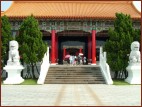 |
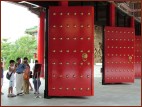 |
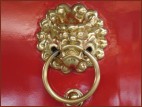 |
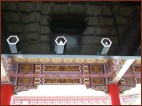 |
| Main
Gate |
Decorative
nails on door leaf on the Main Gate |
Door
knocker of the Main Gate |
Door
viewers on the door head |
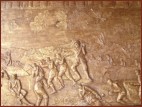 |
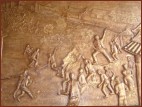 |
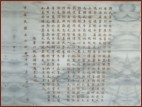 |
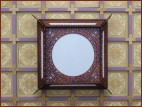 |
| Embossment
depicting The Battle of Shanghai |
Embossment
depicting Guangzhou Uprising |
The
memorial stone of foundation laying |
Patterns
on the ceiling |
Literati
Martyrs' Hall
The roof of Literati Martyrs' Hall is covered
with yellow glazed ceramic roof tiles. Among its beams and pillars
are painted with dragons pattern. Literati Martyrs' Shrine enshrine
martyrs or intellectuals who died for founding the nation, denouncing
President Yuan Shi-Kai for his treason, guarding the Constitution,
fighting in War of Resistance Against Japan, and suppressing
rebellions. Martyrs like Lu Haou-Dong, Lin Chio-Min, Soong Jaou-Ren,
Chu Zhi-Hsin, Lo Fu-Hsin, and the 72 Huanghuagang Revolutionary
Martyrs as well as Taiyuan Five Hundred Perfect Men are enshrined
here. Every year, the minister of Internal Affairs would officiate
spring and autumn national memorials for Literati Martyrs with
five secretariats of the Executive Yuan, Legislative Yuan, Justice
Yuan, Examination Yuan, and Control Yuan.
Military Martyrs' Hall
The Military Martyrs' Hall enshrines soldiers
and military officers who died in the Eastern Expeditions, the
Northern Expeditions, Anti-communist Campaigns, and suppressing
rebellions. Generals are enshrined with an individual tablet,
field officers are listed on hundred-person tablet, while privates
are en masse in patriot rosters in storage. Each year, the minister
of National Defense officiates the spring and autumn national
memorial for military martyrs with Chief of General Staff and
Commanders-in-Chief of Army, Navy, and Air Force.
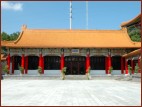 |
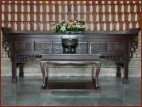 |
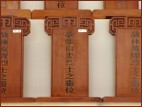 |
 |
| Martyrs'
Hall |
A
niche in martyrs' hall |
Individual
tablet for generals |
Hundred-person
tablet for field officers |
Main
Hall
The Main Hall is a concrete northern-palace
style architecture. The roof style of the Main Hall is called
Wu-Dian. This one is covered with yellow glazed ceramic roof
tiles, which symbolizes the highest social ranking in Ancient
China. The roof ridge is decorated with a celestial and seven
mythical animals. Both dou-gongs (brackets) and dragons patterns
among the beams and pillars follow the exact style of Liang
Sicheng's Construction manual of Qing.
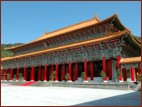 |
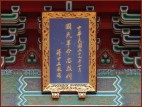 |
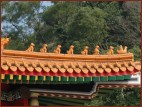 |
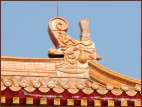 |
| Main
Hall |
Inscribed
board of Martyrs' Shrine in the Main Hall |
A
celestial and seven mythical animals |
Zhengwen
on the roof ridge |
Zou-Ma
Gallery (gallery over the main hall)
In palatial architectures, the gallery over
the main hall of the palace is called Zou-Ma Gallery. Two large
embossments are hung on the Zou-Ma Gallery outside Martyrs'
Shrine's Main Hall. One depicts Victory in Mian Hu Battle,
and the other displays Victory in Kuningtou Battle.
 |
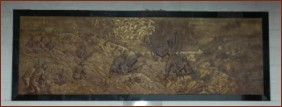 |
| Victory
in Mian Hu Battle |
Victory
in Kuningtou Battle |
Website Translated
by Ou Yang Pei-ting(  Top )
Top ) |
|
